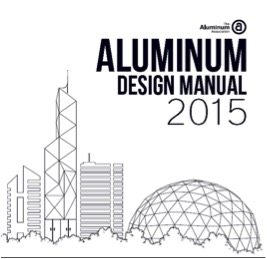By J. Randolph Kissell, The TGB Partnership.
In November 1967, the Aluminum Association published the first edition of the Specification for Aluminum Structures. The document’s purpose was to provide designers the means to calculate the strength of aluminum components in structural applications such as buildings, bridges, and transportation vehicles. Now in its 10th edition and celebrating its 50th anniversary, the Specification is the oldest continuously maintained Association publication after Aluminum Standards and Data, and has proven to have a much greater influence than perhaps its original authors ever imagined.
History of Structural Specifications
Early in the 20th century, aluminum was considered exotic, not structural. In the 1920s, however, Alcoa established an Engineering Design Division, which soon moved to the Alcoa Research Laboratories opened in 1930 in New Kensington, PA, and hired Ernest C. Hartman as its head. Hartman authored the first Alcoa Structural Handbook in 1930, which, along with later similar publications from other producers, such as Reynolds Metals, provided information useful for determining the strength of aluminum structural components. Alcoa subsequently updated the Handbook through the 1960s, with a number of contributors, the most notable of which was John W. Clark, who began a decades long career at Alcoa in 1947 and who would play a key role in developing the Aluminum Association specifications. In the days before computers and even calculators, the engineers who worked on the Alcoa Structural Handbook moved mountains with their minds.
In the 1950s, the American Society of Civil Engineers (ASCE) formed the Task Committee on Lightweight Structural Alloys (i.e., aluminum), staffed largely by aluminum producers. Through this committee, the ASCE published several specifications for aluminum structural design between 1952 and 1962. The scope of each of these specifications was limited to one or two aluminum alloys, however, rather than addressing aluminum in general. These efforts culminated in the December 1962 ASCE publication of Suggested Specifications For Structures of Aluminum Alloys 6061-T6 and 6062-T6 and Suggested Specifications For Structures of Aluminum Alloy 6063-T5 and 6063-T6.

The various publications posed considerable duplication of effort, and with the increasing role of the Aluminum Association in the industry in the 1960s, producers gave the task of collecting and standardizing this information in one place to the Association. The Association formed a Technical Committee on Engineering and Design, chaired by C.M. Tyler, which synthesized the earlier efforts and produced the first Specification for Aluminum Structures in 1967 (Figure 1).
The original Specification for Aluminum Structures produced by the Aluminum Association addressed 13 wrought alloys then common in construction and provided equations for the strength of aluminum structures, members, and connections. Members in axial tension, axial compression, flexure, shear, torsion, and combined loads were addressed. Bolted, riveted, and welded connections were initially included, and later screwed (in 1994) and pinned (in 2015) connections were added. Today, 27 wrought, seven casting, and nine weld filler alloys are within the Specification’s scope.
Specifications for Aluminum Design
Use of the Specification was then and is to this day voluntary. However, soon after its publication, the three American model building code organizations—Building Officials and Code Administrators (BOCA), Southern Building Code Congress International (SBCCI), and International Conference of Building Officials (ICBO) — adopted the Specification in their model codes. In the 1990s, these code organizations merged to become the International Codes Council (ICC), and through efforts of the Aluminum Association they retained the requirement to comply with the Specification, referencing it in Chapter 20 of the International Building Code (IBC), first published in 1997. The significance of the Specification’s place in the IBC should not be underestimated. Without building code recognition, aluminum would not be used in construction requiring building permits, which comprises nearly all residential and commercial construction.
Although development of the Specification has been dominated by civil engineers specializing in structural engineering, its use has not been limited to aluminum in building structures. The Specification has been applied to structural components of many types, including pressure vessels, trailers, light poles, and ships. It is not only the source of all aluminum structural design specifications in the U.S., it also forms the basis of the joint Australia New Zealand standard AS/NZS 1664.
Through its first five editions (1967, 1971, 1976, 1982, and 1986), the Specification was published as Section 1 of the Aluminum Association’s Aluminum Construction Manual. The manual also included Section 1A, “Commentary on Specifications for Aluminum Structures,” first written by John Clark and published in 1971, providing references to research on which the Specification was based. Section 2, “Illustrative Examples of Design,” first published in 1978, presented sample problems showing how to apply the Specification’s provisions, while Section 3, “Engineering Data for Aluminum Structures,” first published in 1969 included tables of common structural shapes with their dimensions and properties, as well as beam formulas and other useful design tables. The Aluminum Construction Manual also included Section 5, “Specifications for Aluminum Sheet Metal Work in Building Construction.” (Section 4 somehow never materialized.)
The original Technical Committee on Engineering and Design changed to the Engineering and Design Task Force (EDTF) in 1986, although its role in preparing and voting on changes to the Specification remained the same. An Engineering Advisory Committee was also formed to review and have a final vote on changes to the Specification approved by the EDTF. John Clark of Alcoa chaired the EDTF in the 1970s and continued to serve the committee as a voting member after this retirement in 1980. He was succeeded by Maurice L. Sharp, also from Alcoa, who chaired the task force from 1980 until 1994. In 1992, Sharp authored Behavior and Design of Aluminum Structures, a book on aluminum structural design, which provided background for many of the Specification’s later provisions.

At Sharp’s initiative, in 1994, the Association collected the sections of the Aluminum Construction Manual and incorporated them into the Aluminum Design Manual (ADM), a loose-leaf binder with parts corresponding to the Aluminum Construction Manual sections (Figure 2). The ADM contained the Specification for Aluminum Structures as Part I, but presented it in two versions: one for Allowable Stress Design (ASD) and a newer, second version for Load and Resistance Factor Design (LRFD), developed with the aid of Ted Galambos of the University of Washington. This kept the aluminum Specification current with the design specifications of materials, such as steel and concrete, which included the newer LRFD design method.
In ASD method, member strengths are divided by a safety factor (a number greater than one) to determine an available strength (also called an allowable strength) and compared to the forces in the member determined using unfactored loads, which, in the case of building structures, are prescribed by building codes. In the LRFD method, member strengths are multiplied by a resistance factor (a number less than one) to determine an available strength (also called a design strength) and compared to the forces in the member determined using factored loads, with the loads and their factors typically prescribed by bridge and building codes. The member sizes determined by the two methods are approximately the same, but LRFD provides a more rational approach by distinguishing between the variability of different loads.
The Specification’s safety factors for building structures of 1.65 on yielding and 1.95 on rupture have not changed since the Specification’s first edition, and are very similar to the factors used in the Specification for Structural Steel Buildings.
Significant Updates
Subsequent Aluminum Design Manual editions were published in 2000, 2005, 2010, and 2015, and included revisions to the Specification for Aluminum Structures. The 2000 edition debuted friction connections, which use pretensioned high-strength steel bolts to connect aluminum parts with roughened faying surfaces to create slip-resistant joints. The research for these connections was conducted by Reynolds Metals, which was engaged in promoting highway bridge decks made of aluminum at the time.
The biggest changes came with the 2010 edition, which presented the first reorganization of the Specification since its conception in 1967. The new organization method used the same chapter titles and numbering system as the 2005 Specification for Structural Steel Buildings published by the American Institute for Steel Construction (AISC). It also merged the ASD and LRFD versions of the Specification into a unified specification, as the AISC had done. These changes made the aluminum design specification easier for most structural engineers to use, since they are usually taught the steel Specification in college and thus are more familiar with its format.
The 2010 Specification also had a significantly expanded scope. For the first time, the Specification addressed second order effects in determining the forces acting in aluminum structures, serviceability, braces for members in compression, design for fire conditions, and the evaluation of existing structures.
The 2015 edition of the Specification was the first aluminum design specification in the world to include friction stir welded joints in addition to arc welded joints.
Changes to the Specification over the years have been based on research conducted at universities and producer’s laboratories, most notably the Alcoa Research Laboratories and its successor, the Alcoa Technical Center in Alcoa Center, PA, which opened in 1965. The committee included members from universities, who contributed research and knowledge to the Specification, including the Polytechnic Institute of Brooklyn, Cornell University, the University of Akron, and Bucknell University. For example, provisions for fatigue were first included in the Specification in 1986 based on research conducted by Prof. Wallace Sanders of Iowa State University, and later by Dr. Craig Menzemer of the University of Akron. The Aluminum Association has funded much of this research and hosted the EDTF meetings that turn the data into design rules.
Future Iterations
Continuing the post-2000 trend of a five-year revision cycle, the next edition of the Specification for Aluminum Structures is scheduled for 2020. The EDTF has already approved significant additions, including the pull-out strength of screws in extruded screw chases. Although the original authors of the Specification might be surprised by its current breadth, I like to think that they would be quite pleased at the advances in aluminum structural design that the Specification makes available to designers today.
Editor’s Note: The Specification for Aluminum Structures can be obtained as part of the Aluminum Design Manual, which can be ordered from the Aluminum Association’s bookstore at: www.aluminum.org/bookstore.
This article first appeared in the October 2017 issue of Light Metal Age. To read more articles from this issue, please subscribe.
J. Randolph Kissell P.E. co-founded the TGB Partnership, an engineering firm specializing in aluminum structures, in 1993. He has been involved in the design, fabrication, erection, and inspection of aluminum structures since 1978, including 12 years as the engineering manager of Conservatek, an aluminum spaceframe manufacturer and erector. Randy co-authored Aluminum Structures – A Guide to Their Specifications and Design, published by John Wiley and now in its 2nd edition, and co-holds numerous U.S. patents for aluminum structures. Kissel has served on the Aluminum Association’s Engineering and Design Task Force since 1990, the AWS D1.2 aluminum welding committee, and has taught “Designing Aluminum Structures” for the American Society of Civil Engineers since 2002.

